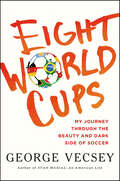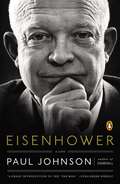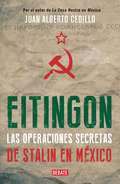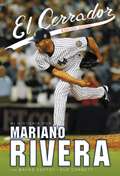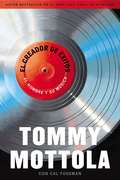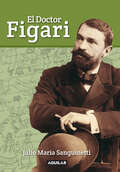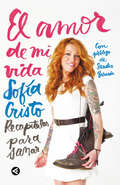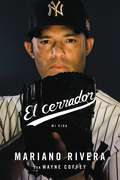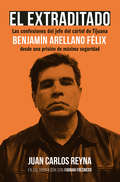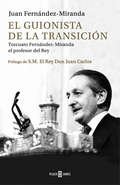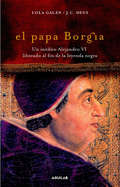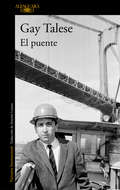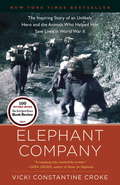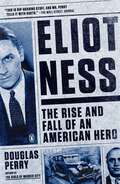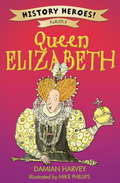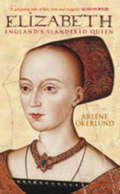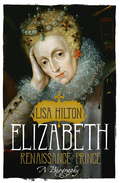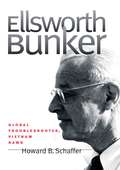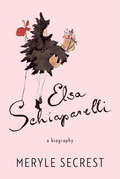- Table View
- List View
Eight World Cups: My Journey through the Beauty and Dark Side of Soccer
by George Vecsey"Full of humor and insight about sport and culture.... The pomp, glory, and great entertainment all get their due in Eight World Cups."—The Boston GlobeBlending witty travelogue with action on the field—and shady dealings in back rooms—George Vecsey offers an eye-opening, globe-trotting account of eight World Cups. He immerses himself in the great national leagues, historic clubs, and devoted fans and provides his up-close impressions of charismatic soccer stars like Sócrates, Maradona, Baggio, and Zidane, while also chronicling the rise of the U.S. men's and women's teams.Vecsey shows how each host nation has made the World Cup its own, from the all-night street parties in Spain in 1982 to the roar of vuvuzelas in South Africa in 2010, as the game in the stadium is backed up by the game in the street. But the joy is sometimes undermined by those who style themselves the game's protectors.
Einstein's Opponents
by Milena Wazeck Geoffrey S. KobyThis detailed account of the controversy surrounding the publication of Albert Einstein's theory of relativity explores the ferocious popular and academic opposition which at one time encircled one of the most important scientific breakthroughs of the twentieth century. Based on extensive archival research, this fascinating discourse includes a compelling and entertaining examination of the contemporary literature created by Einstein's detractors. Exploring the arguments and strategies, social contexts, and motivations of Einstein's detractors, and providing unique insights into the dynamics of scientific controversies, this book is ideal for anyone interested in the history and philosophy of physics, popular science, and the public understanding of science.
Eisenhower
by Paul JohnsonAcclaimed historian Paul Johnson's lively, succinct biography of Dwight D. Eisenhower explores how his legacy endures today In the rousing style he's famous for, celebrated biographer Paul Johnson offers a fascinating portrait of Dwight D. Eisenhower, focusing particularly on his years as a five-star general and his time as the thirty-fourth President of the United States. Johnson chronicles President Eisenhower's modest childhood in Kansas, his college years at West Point, and his rapid ascent through the military ranks, culminating in his appointment as Supreme Commander of the Allied Forces in Europe during World War II. Beginning when Eisenhower assumed the presidency from Harry Truman in 1952, Johnson paints a rich portrait of his two consecutive terms, exploring his volatile relationship with then-Vice President Richard Nixon, his abhorrence of isolationism, and his position on the Cold War, McCarthyism, and the Civil Rights Movement. Johnson notes that when Eisenhower left the White House at age 70, reluctantly passing the torch to President-elect John F. Kennedy, he feared for the country's future and prophetically warned of the looming military-industrial complex. Many elements of Eisenhower's presidency speak to American politics today, including his ability to balance the budget and skill in managing an oppositional Congress. This brief yet comprehensive study will appeal to biography lovers as well as to enthusiasts of presidential history and military history alike.
Eisenhower
by Paul JohnsonAcclaimed historian Paul Johnson's lively, succinct biography of Dwight D. Eisenhower explores how his legacy endures today In the rousing style he's famous for, celebrated biographer Paul Johnson offers a fascinating portrait of Dwight D. Eisenhower, focusing particularly on his years as a five-star general and his time as the thirty-fourth President of the United States.Johnson chronicles President Eisenhower's modest childhood in Kansas, his college years at West Point, and his rapid ascent through the military ranks, culminating in his appointment as Supreme Commander of the Allied Forces in Europe during World War II. Beginning when Eisenhower assumed the presidency from Harry Truman in 1952, Johnson paints a rich portrait of his two consecutive terms, exploring his volatile relationship with then-Vice President Richard Nixon, his abhorrence of isolationism, and his position on the Cold War, McCarthyism, and the Civil Rights Movement. Johnson notes that when Eisenhower left the White House at age 70, reluctantly passing the torch to President-elect John F. Kennedy, he feared for the country's future and prophetically warned of the looming military-industrial complex.Many elements of Eisenhower's presidency speak to American politics today, including his ability to balance the budget and skill in managing an oppositional Congress. This brief yet comprehensive study will appeal to biography lovers as well as to enthusiasts of presidential history and military history alike.
Eitingon, las operaciones secretas de Stalin en México
by Juan Alberto CedilloLa misión más importante en la vida de Leónidas Eitingon surgió bajo las órdenes de Stalin: eliminar a su peor enemigo, León Trotsky, exiliado en la ciudad de México desde 1937.Tras fallar un primer intento coordinado con David Alfaro Siqueiros, en una segunda ocasión Eitingon mezcló los peligrosos movimientos de la denominada Operación Pato con su pasatiempo favorito: conquistar bellas mujeres. Finalmente, el 20 de agosto de 1940, el ideólogo más importante de la revolución bolchevique fue asesinado. Ramón Mercader, hijo de la amante y cómplice del emblemático agente, fue el encargado de concluir la misión.A partir de documentos desclasificados del Archivo Nacional de Seguridad estadounidense, Juan Alberto Cedillo -autor de Los nazis en México- nos ofrece una fascinante trama digna de una novela de espías, aderezada con intrigas y pugnas de alto calibre.Situada durante los años cuarenta, la historia pone al descubierto las maquinaciones orquestadas por los servicios secretos soviéticos en México para matar al principal opositor al régimen, rescatar de la cárcel al homicida y espiar los trabajos científicos de construcción de la bomba atómica.
El Cerrador: Edición Juvenil
by Wayne Coffey Sue Corbett Mariano RiveraMariano Rivera nunca soñó en llegar a ser un atleta profesional. Él nunca coleccionó tarjetas de béisbol, ni jugó en Pequeñas Ligas ni vitoreó a su equipo en una Serie Mundial. Él tampoco oyó hablar de Babe Ruth, Lou Gehrig, Joe DiMaggio o Mickey Mantle.Pero un día, todo cambió.De ser un niño que jugaba con sus amigos en Panamá hasta ser un deportista exitoso con los Yankees de Nueva York, la vida de Mariano se convirtió en algo grandioso que jamás él pensó. Cuando él se para en el montículo no oye a la multitud, sólo oye la voz del árbitro gritando: "¡Strike!". Es el compañero de juego en el que puedes confiar, aun cuando las bases están llenas en la parte baja de la novena entrada. Sea que lo conozcas como Mo o como el "Sandman", Mariano es El cerrador y esta es su historia.Lleno de consejos para atletas jóvenes y anécdotas del equipo de los Yankees, El cerrador: Edición juvenil es una inspiradora historia de perseverancia, espíritu deportivo y dedicación que han definido la vida de una leyenda del béisbol.
El Creador de Exitos: El hombre y su musica
by Tommy MottolaSe ha escrito mucho acerca de Tommy Mottola, uno de los ejecutivos más poderosos, visionarios y exitosos en la historia de la industria de la música. Descubrió, desarrolló y acompañó el progreso profesional de muchas súper estrellas incluyendo a Mariah Carey, Celine Dion, Shakira, Jennifer Lopez y Gloria Estefan, y es reconocido como el creador de la "explosión latina". Ha tenido el privilegio de trabajar al lado de Bruce Springsteen, Billy Joel, Bob Dylan, Beyoncé, Michael Jackson, Barbra Streisand, las Dixie Chicks, Pearl Jam, Aerosmith, Tony Bennett y Ozzy Osbourne, entre otros gigantes de la música. Esta es su historia - la historia de la industria de la música moderna, desde Elvis hasta el iPod - a través de los ojos del hombre que hizo que la mayor parte del desarrollo de esta industria fuera posible. EL CREADOR DE ÉXITOS relata la forma como un muchacho del Bronx -un desertor escolar- se convirtió en uno de los CEOs más creativos y controversiales de la industria de la música. Por primera vez, Tommy pone al descubierto los hechos tras los aspectos más sensacionales de su vida, como el de haber estado casado con Mariah Carey y haber desarrollado la carrera de esta artista, haber sido la persona encargada de manejar los altibajos emocionales de Michael Jackson, haber tenido la fuerza para enfrentarse a quien fuera en una época su jefe y su mentor, Walter Yetnikoff. EL CREADOR DE ÉXITOS nos llevará a ese mundo de poder, dinero y fama, a medida que nos narra sus fascinantes encuentros con incontables íconos y lo que fue para Tommy Mottola estar en la cima en el momento en el que el negocio sufrió un cambio repentino. La historia de Tommy es una que jamás podrá igualarse, y está aquí, por primera vez, en su propia voz.
El Doctor Figari
by Julio María SanguinettiEsta es la historia, en fin, de una trayectoria de auténtica humanidad,la de un hombre polifacético como pocos, narrada con profundidad ypasión, lográndose un texto que desborda la condición de biografía paraconvertirse "seguramente como le hubiera gustado al propio Figari" en unensayo histórico-filosófico que puede resultarnos efectivamentecontemporáneo. Esta es la reedición de El Doctor Figari, cuya primera edición sepublicó en 2002, y que se encontraba agotada desde hace mucho tiempo.En este libro se narra la peripecia de un auténtico "hombre universal",una suerte de ?Leonardo? uruguayo, ávido de saberes, oficios y pasiones.De ese modo, no es solo al reconocido plástico al que se registra:también destacan su empecinada y altruista tarea como Defensor deOficio; su arduo y muchas veces incomprendido desempeño como Director dela Escuela Nacional de Artes y Oficios; su cercanía con los políticos demayor fuste del momento. Pero más allá de todas estas actividades, eneste texto el Dr. Sanguinetti evoca también al filósofo y al pedagogo,al pensador y humanista que se adentró en la elaboración de entramadosconceptuales originales que aún hoy nos interpelan.No falta el Figari admirado y respetado por otros intelectuales yartistas que con él compartieron, en América y Europa, tiempos deefervescencia creativa, como Güiraldes, Reyles, Borges, Martinenche,Lesca, Delacroix, Roustan, Supervielle, Valéry, Ortega y Gasset... Perotampoco se deja en el olvido al Figari hombre de familia, al padresiempre pendiente de sus hijos, por quienes bregó para que nada lesfaltara, aun en su edad avanzada y no obstante haber sufrido grandessinsabores y pérdidas afectivas.
El amor de mi vida
by Sofía CristoDiario de una desintoxicación, una nueva vida. «Este es un libro duro, sincero, divertido, humano.Esta es una historia real.Esta es mi historia.»Sofía Cristo Sofía Cristo, la hija menor de Bárbara Rey y Ángel Cristo, relata en un libro duro y eminentemente real su experiencia al lado del amor de su vida: la droga, una compañera que ha pululado a su alrededor desde que era una niña y a quien se ha tenido que enfrentar. Una vez recuperada, después de más de un año en un centro de rehabilitación, la DJ profesional renace de sus cenizas para romper de manera definitiva con el que ha sido hasta ahora el amor de su vida y para compartir con los demás su testimonio de superación.
El cerrador: Mi vida
by Wayne Coffey Mariano RiveraThe greatest relief pitcher of all time shares his extraordinary story of survival, love, and baseball.Mariano Rivera, the man who intimidated thousands of batters merely by opening a bullpen door, began his incredible journey as the son of a poor Panamanian fisherman. When first scouted by the Yankees, he didn't even own his own glove. He thought he might make a good mechanic. When discovered, he had never flown in an airplane, had never heard of Babe Ruth, spoke no English, and couldn't imagine Tampa, the city where he was headed to begin a career that would become one of baseball's most iconic. What he did know: that he loved his family and his then girlfriend, Clara, that he could trust in the Lord to guide him, and that he could throw a baseball exactly where he wanted to, every time.With astonishing candor, Rivera tells the story of the championships, the bosses (including The Boss), the rivalries, and the struggles of being a Latino baseball player in the United States and of maintaining Christian values in professional athletics. The thirteen-time All-Star discusses his drive to win; the secrets behind his legendary composure; the story of how he discovered his cut fastball; the untold, pitch-by-pitch account of the ninth inning of Game 7 in the 2001 World Series; and why the lowest moment of his career became one of his greatest blessings.In The Closer, Rivera takes readers into the Yankee clubhouse, where his teammates are his brothers. But he also takes us on that jog from the bullpen to the mound, where the game -- or the season -- rests squarely on his shoulders. We come to understand the laserlike focus that is his hallmark, and how his faith and his family kept his feet firmly on the pitching rubber. Many of the tools he used so consistently and gracefully came from what was inside him for a very long time -- his deep passion for life; his enduring commitment to Clara, whom he met in kindergarten; and his innate sense for getting out of a jam.When Rivera retired, the whole world watched -- and cheered. In The Closer, we come to an even greater appreciation of a legend built from the ground up.
El extraditado. Benjamín Arellano Félix
by Juan Carlos Reyna Farrah Fresnedo"Si para algo soy bueno, es para hacer la guerra..."El extraditado constituye el retrato implacable sobre Benjamín Arellano Félix, jefe máximo del Cártel de Tijuana, una de las organizaciones criminales más poderosas durante la década de los noventa. Desde una perspectiva cercana, la historia muestra el testimonio directo del protagonista, siendo la primera vez que un capo mexicano ofrece su versión de los hechos desde la extradición en Estados Unidos.Con un estilo vertiginoso, siempre exento de juicios morales, Juan Carlos Reyna despliega una impactante crónica donde la voz del personaje principal confluye con información inédita de diversos expedientes judiciales. Así, el lector va descubriendo los entresijos de varios hitos en la historia del narcotráfico, como la balacera de la discoteca Christine, el asesinato del cardenal Posadas Ocampo o la detención del propio Benjamín Arellano en Puebla."Tuve la impresión -afirma el autor- de que la historia de los Arellano Félix, entrecruzada con la de México en general, era una sucesión brutal de ajusticiamientos." Situado más allá de la trinchera periodística, en ese recorrido lleno de velocidad y desconcertantes giros se ponen al desnudo las entrañas del cártel: sus nexos empresariales-políticos, sus jerarquías y modos de operar. El resultado es una compleja y profunda visión sobre la acumulación de poder a través del feroz ejercicio de la violencia."A mí me extraditó el PAN, porque a mí el PRI no me extradita..."
El guionista de la Transición: Torcuato Fernández-Miranda, el profesor del Rey
by Juan Fernández-MirandaLa primera biografía dedicada a Torcuato Fernández-Miranda, figura imprescindible de la Transición Una de las definiciones más acertadas que se han hecho de la Transición es aquella popularizada por Rodolfo Martín Villa en la que se la describe como un montaje teatral en el que «el Rey fue el empresario, Torcuato Fernández-Miranda el guionista y Adolfo Suárez el actor que interpretaba el guion escrito por Torcuato». Si bien son muchos los libros dedicados a las figuras del empresario y el actor, resulta sorprendente saber que no existe una sola biografía dedicada al guionista, por lo que este libro viene a llenar un injusto silencio acerca de otro protagonista esencial de este reparto: Torcuato Fernández-Miranda. Suya fue la responsabilidad de educar al joven príncipe desde 1960 y de diseñar un plan que le condujera a la corona, sorteando los obstáculos que en su camino sembraban los fieles del búnker franquista; suya fue la Presidencia del gobierno en los decisivos días que siguieron al asesinato de Carrero Blanco y que pudieron dar al traste con la hoja de ruta prevista para la llegada de la democracia; suya fue la decisión de renunciar a su mayor ambición política, ser presidente del Gobierno, al considerar que sería más valioso para los planes del Rey desde la presidencia de las Cortes; suya fue la astuta maniobra que logró la terna de candidatos que llevó a Suárez a la presidencia del Gobierno, y que, en sus propias palabras, incluía «lo que el Rey me ha pedido»; y por último, suya fue también la redacción de la ley fundamental que entregó a Suárez diciéndole «aquí tienes esto, que no tiene padre», y que se convirtió en la pieza definitiva para conseguir el desmantelamiento del Régimen franquista sin provocar un nuevo enfrentamiento civil. Como atractivo adicional, este libro está prologado por S. M. el Rey Don Juan Carlos I. Por primera vez el rey emérito escribe un prólogo para un libro, lo que supone un claro gesto de gratitud hacia quien fuera su preceptor y hombre de confianza. Los protagonistas de la época opinan... «A mí la suerte me sonríe a menudo. Tengo el don de atraparla al paso, incluso de provocarla. Pero la suerte tiene toda clase de rostros. La mía ha consistido en tener siempre a mi lado al hombre que hacía falta en las situaciones delicadas. Sin duda Torcuato ha sido uno de esos hombres.» Juan Carlos I «Torcuato Fernández-Miranda fue el político más relevante del siglo XX.» Adolfo Suárez «La transición tuvo, sin duda, una gran fortuna: contar con las personas adecuadas en el momento apropiado. Una de ellas, y fundamental, fue Torcuato. También procedente del régimen anterior, esa circunstancia fue superada por sus capacidades: la técnica, el conocimiento de las claves del Estado, el saber moverse entre las nieblas de la política, una extraordinaria imaginación, un sutil dominio de las voluntades, una formación jurídica extraordinaria y una posición de confianza al lado de Su Majestad el Rey.» Fernando Ónega «Fue Fernández-Miranda el estadista que se sirvió del arrojo -a veces temerario- de Adolfo Suárez para ese brinco aparentemente imposible que consistió en transitar de una dictadura a una democracia.» José Antonio Zarzalejos
El papa Borgia: Un inédito Alejandro VI liberado al fin de la leyenda negra
by Lola Galán José Catalán DeusEn este libro se ofrece una visión inédita de un Papa-rey que despertó gigantescas envidias. Es momento de rescatar a Alejandro VI del sumidero de una historia casi siempre interesada. ¿Fue el papa Borgia un político competente o un embaucador corrupto? ¿Cuidó de la Iglesia o la usó para promocionar a su familia? ¿Fue un ser humano con sus defectos y virtudes al timón de una institución sumamente compleja o un malvado asesino? Durante siglos la respuesta ha estado clara para el común de los historiadores y novelistas, que han encontrado en la vida de Rodrigo Borja, valenciano de nacimiento y romano de adopción, elementos suficientes para construir un relato de terror, plagado de ambición, sexo y veneno. La realidad, sin embargo, es otra. Los datos históricos de que disponemos permiten reconstruir la biografía de este Papa que, libre de la leyenda, emerge como una figura de excepcionales cualidades. Vicecanciller vaticano durante tres décadas y pontífice católico durante diez años vitales para la Iglesia, aseguró la supervivencia de la institución a él encomendada gracias a sus grandes dotes políticas, diplomáticas y humanas. Tildado de lujurioso y homicida, Alejandro VI fue un hombre apasionado, carnal y tolerante, entregado a su familia y a la defensa de la Iglesia. Pocos personajes de la historia han sido tan calumniados como él por difamadores a sueldo de sus rivales políticos. La verdad es sorprendente y más apasionante que los tópicos.
El puente
by Gay TaleseEl Maestro del Periodismo narra una auténtica epopeya humana: la crónica de la construcción de un puente convertida en un nuevo clásico. «Talese cuenta historias cálidas, divertidas y trágicas sobre hombres, mujeres, acero y hormigón. Una buena lectura.»Denver Post «Llegan a la ciudad en coches enormes, viven en habitaciones amuebladas, beben whisky acompañado de chupitos de cerveza y persiguen a mujeres que no tardarán en olvidar. Se quedan poco tiempo, no más del que necesitan para construir el puente.» A finales de 1964 se completaron las obras del puente de Verrazano-Narrows, que une Brooklyn y Staten Island y que, medio siglo después, sigue considerándose un prodigio de la ingeniería: con sus 4.176 metros de longitud, es el puente colgante más largo de Estados Unidos y el sexto del mundo. Gay Talese, que siguió de cerca el levantamiento de este monumento al esfuerzo del hombre, recogió en El puente las historias humanas que se hallaban tras su construcción, desde el día a día de los obreros que trabajaban sobre vigas a alturas de vértigo hasta los acuerdos a puerta cerrada que desplazarían vecindarios enteros para dar cabida a la bestia. Un relato fascinante de intrigas políticas y de coraje, y una demostración del talento de Talese como cronista y narrador de historias. Reseñas:«Una crónica brillante. Describe con emoción a la gente que participó en el proyecto. Ve en el puente un logro humano más que mecánico, y aporta drama y aventura a la historia de su construcción.»The New York Times Book Review «Este libro tiene el encanto de I Cover the Waterfront, de Max Miller, y la precisión de Muerte en la tarde, de Hemingway.»St. Louis Post-Dispatch «Solo un escritor enamorado de su materia puede producir un relato tan fascinante. Hay muchas historias dentro de El puente, y todas merecen ser leídas.»Houston Post «Un relato maravilloso en el que combina tristeza, humor, peligro, muerte y angustia, y que al lector le resultará difícil dejar.»Arizona Republic «Un relato fascinante y atractivo. Un drama absorbente y maravillosamente escrito.»Times Union «Talese cuenta historias cálidas, divertidas y trágicas sobre hombres, mujeres, acero y hormigón. Una buena lectura.»Denver Post
Election Administration in the United States
by R. Michael Alvarez Bernard GrofmanThis book tells the story of how the way in which we conduct elections has changed after the Florida recount litigation of 2000. Some of the nation's leading experts look at various aspects of election administration, including issues of ballot format, changes in registration procedures, the growth in the availability of absentee ballot rules and other forms of "convenience voting," and changes in the technology used to record our votes. They also look at how the Bush v. Gore decision has been used by courts that monitor the election process and at the consequences of changes in practice for levels of invalid ballots, magnitude of racial disparities in voting, voter turnout, and access to the ballot by those living outside the United States. The editors, in their introduction, also consider the normative question of exactly what we want a voting system to do. An epilogue by two leading election law specialists looks at how election administration and election contest issues played out in the 2012 presidential election.
Elephant Company: The Inspiring Story of an Unlikely Hero and the Animals Who Helped Him Save Lives in World War II
by Vicki Constantine CrokeThe remarkable story of James Howard “Billy” Williams, whose uncanny rapport with the world’s largest land animals transformed him from a carefree young man into the charismatic war hero known as Elephant Bill<P> Billy Williams came to colonial Burma in 1920, fresh from service in World War I, to a job as a “forest man” for a British teak company. Mesmerized by the intelligence, character, and even humor of the great animals who hauled logs through the remote jungles, he became a gifted “elephant wallah.” Increasingly skilled at treating their illnesses and injuries, he also championed more humane treatment for them, even establishing an elephant “school” and “hospital.” In return, he said, the elephants made him a better man. The friendship of one magnificent tusker in particular, Bandoola, would be revelatory. In Elephant Company, Vicki Constantine Croke chronicles Williams’s growing love for elephants as the animals provide him lessons in courage, trust, and gratitude.<P> But Elephant Company is also a tale of war and daring. When Imperial Japanese forces invaded Burma in 1942, Williams joined the elite Force 136, the British dirty tricks department, operating behind enemy lines. His war elephants would carry supplies, build bridges, and transport the sick and elderly over treacherous mountain terrain. Now well versed in the ways of the jungle, an older, wiser Williams even added to his stable by smuggling more elephants out of Japanese-held territory. As the occupying authorities put a price on his head, Williams and his elephants faced his most perilous test. In a Hollywood-worthy climax, Elephant Company, cornered by the enemy, attempted a desperate escape: a risky trek over the mountainous border to India, with a bedraggled group of refugees in tow. Elephant Bill’s exploits would earn him top military honors and the praise of famed Field Marshal Sir William Slim.<P> Part biography, part war epic, and part wildlife adventure, Elephant Company is an inspirational narrative that illuminates a little-known chapter in the annals of wartime heroism.
Elijah McCoy: A Life of Invention (Fountas & Pinnell LLI Purple #Level T)
by Kate FosterAgainst the Odds. How can one person make over fifty inventions in a single lifetime? He's got to be the best--the real McCoy! Meet Elijah McCoy, mechanical engineer and inventor extraordinaire. Find out how the son of escaped slaves used his unusual talents to overcome discrimination and become an important inventor of his time.
Eliot Ness
by Douglas PerryThe true story of Eliot Ness, the legendary lawman who led the Untouchables, took on Al Capone, and saved a city's soul Eliot Ness is famous for leading the Untouchables against the notorious mobster Al Capone. But it turns out that the legendary Prohibition Bureau squad's daring raids were only the beginning. Ness's true legacy reaches far beyond Big Al and Chicago. Eliot Ness follows the lawman through his days in Chicago and into his forgotten second act. As the public safety director of Cleveland, he achieved his greatest success: purging the city of corruption so deep that the mob and the police were often one and the same. And it was here, too, that he faced one of his greatest challenges: a brutal, serial killer known as the Torso Murderer, who terrorized the city for years. Eliot Ness presents the first complete picture of the real Eliot Ness. Both fearless and shockingly shy, he inspired courage and loyalty in men twice his age, forged law-enforcement innovations that are still with us today, and earned acclaim and scandal from both his professional and personal lives. Through it all, he believed unwaveringly in the integrity of law and the basic goodness of his fellow Americans.
Eliot Ness
by Douglas PerryThe story of Eliot Ness, the legendary lawman who led the Untouchables, took on Al Capone, and saved a city's soulAs leader of an unprecedented crime-busting squad, twenty-eight-year-old Eliot Ness won fame for taking on notorious mobster Al Capone. But the Untouchables' daring raids were only the beginning of Ness's unlikely story.This new biography grapples with the charismatic lawman's complicated, largely forgotten legacy. Perry chronicles Ness's days in Chicago as well as his spectacular second act in Cleveland, where he achieved his greatest success: purging the profoundly corrupt city and forging new practices that changed police work across the country. He also faced one of his greatest challenges: a mysterious serial killer known as the Torso Murderer. Capturing the first complete portrait of the real Eliot Ness, Perry brings to life an unorthodox man who believed in the integrity of law and the power of American justice.acclaim and scandal from both his professional and personal lives. Through it all, he believed unwaveringly in the integrity of law and the basic goodness of his fellow Americans.
Elizabeth I
by Rupert Van Wyk Damian HarveyElizabeth I ruled during a turbulent time in Tudor history. Find out about her highs and lows from being imprisoned in the Tower of London to inspiring victory over the Spanish Armada. Discover the stories of people who have helped to shape history, ranging from early explorers such as Christopher Columbus to more modern figures like Tim Berners-Lee, inventor of the World Wide Web. These chapter books combine historical fact with engaging narrative and humourous illustration, perfect for the newly independent reader.
Elizabeth I (History Heroes #3)
by Damian HarveyElizabeth I ruled during a turbulent time in Tudor history. Find out about her highs and lows from being imprisoned in the Tower of London to inspiring victory over the Spanish Armada.Discover the stories of people who have helped to shape history, ranging from early explorers such as Christopher Columbus to more modern figures like Tim Berners-Lee, inventor of the World Wide Web.These chapter books combine historical fact with engaging narrative and humourous illustration, perfect for the newly independent reader.
Elizabeth: England's Slandered Queen
by Arlene OkerlundElizabeth Wydeville, Queen consort to Edward IV, has traditionally been portrayed as a scheming opportunist. But was she a cunning vixen or a tragic wife and mother? As this extraordinary biography shows, the first queen to bear the name Elizabeth lived a tragedy, love, and loss that no other queen has since endured. This shocking revelation about the survival of one woman through vilification and adversity shows Elizabeth as a beautiful and adored wife, distraught mother of the two lost Princes in the Tower, and an innocent queen slandered by politicians.
Elizabeth: Renaissance Prince
by Lisa HiltonA definitive portrait of one of the most compelling monarchs England has ever had: Elizabeth I.'We are a prince from a line of princes.'Lisa Hilton's majestic biography of Elizabeth I, 'The Virgin Queen', uses new research to present a fresh interpretation of Elizabeth as a queen who saw herself primarily as a Renaissance prince, delivering a very different perspective on her emotional and sexual life, and upon her attempts to mould England into a European state. Elizabeth was not an exceptional woman but an exceptional ruler, and this book challenges readers to reassess her reign, and the colourful drama, scandal and intrigue to which it is always linked.
Ellsworth Bunker
by Howard B. SchafferIn this first biography of Ellsworth Bunker (1894-1984), Howard Schaffer traces the life of one of postwar America's foremost diplomats from his formative years as a successful businessman and lobbyist through a long career in international affairs.Named ambassador to Argentina by Harry Truman in 1951, Bunker went on to serve six more presidents as ambassador to Italy, India, Nepal, and Vietnam and on special negotiating missions. A widely recognized "hawk," Bunker helped shape U.S. policy in Vietnam during his six-year Saigon posting. Using letters Bunker wrote to his wife as well as recently declassified messages he exchanged with Henry Kissinger, Schaffer examines how Bunker promoted the war effort and how he regarded his mission. After leaving Saigon on his seventy-ninth birthday, Bunker next became a key figure in the treaty negotiations, spanning three presidencies, that radically changed the operation and defense of the Panama Canal.Highlighting Bunker's views on the craft of diplomacy, Schaffer paints a complex picture of a man who devoted three decades to international affairs and sheds new light on post-World War II American diplomacy.This book is part of the ADST-DACOR Diplomats and Diplomacy Series, co-sponsored by the Association for Diplomatic Studies and Training in Arlington, Virginia, and Diplomatic & Consular Officers, Retired, Inc., of Washington, D.C.
Elsa Schiaparelli
by Meryle SecrestHer name was Elsa Schiaparelli. She was known as the Queen of Fashion; a headline attraction in the international glitter-glamour show of the late twenties and thirties, feted in Rome (where she was born), Paris, New York, London, Moscow, Hollywood . . . Her style was a social revolution through clothing--luxurious, eccentric, ironic, sexy. Her fashions, inspired, from the whimsical to the most practical--from a Venetian cape of the commedia dell'arte to the Soviet parachute. She collaborated with some of the greatest artists of the twentieth century: on jewelry designs with Jean Schlumberger; on clothes with Salvador Dalí (his lobster dress for her, a lobster garnished with parsley painted on the skirt of an organdy dress, was instantly bought by Wallis Simpson for her honeymoon with the Duke of Windsor); with Jean Cocteau, Alberto Giacometti, Christian Bérard, photographers Baron Adolph de Meyer, Horst, Cecil Beaton, and the young Richard Avedon. She was the first designer to use rayon and latex, thick velvets, transparent and waterproof, and cellophane. Her perfume--Shocking!--was a bottle in the shape of a bust sculpted by Léonor Fini, inspired by the body of Mae West. Her boutique at an eighteenth-century palace at 21 Place Vendôme opened into a cage designed by Jean-Michel Frank. American Vogue, in 1927, presented her entire collection as Works of Art. A decade later, she was the first European to win the Neiman Marcus Fashion Award. Here is the never-before-told story of this most extraordinary fashion designer, perhaps the most extraordinary fashion designer of the twentieth century, in her day more famous than Chanel. Meryle Secrest, acclaimed biographer, who has captured the lives of many of the twentieth century's most iconic cultural figures, among them: Frank Lloyd Wright, Bernard Berenson, and Modigliani, gives us the first full life of the grand couturier--surrealist and embattled figure--whose medium was apparel. "Dare to be different," Schiaparelli advised women, and she lived it to the height; a rebel against convention--social as well as fashion. She designed an otter-fur bathing suit and a hat inspired by a lamb chop. ("I like to amuse myself," she said. "If I didn't, I would die.") Chanel, her arch rival, called her, "that Italian woman who makes dresses." Here is the story of Schiaparelli's rise to fame (as brazen and unique as any of the artistic creations that emerged from her Paris workrooms before World War II); her emotionally starved upbringing in Rome (her mother was part Scottish, part Neapolitan; her father, a prominent medieval scholar specializing in Islamic manuscripts, dean of the faculty of Rome; her uncle, an astronomer famous for his description in 1877 of "canals" on Mars); her years overshadowed by a prettier sister; her elopement with a Swiss-born man who claimed to be a count, disciple of mysticism and the occult--who managed to get himself and his young bride deported from Britain . . . her struggle to care for her polio-stricken daughter, Gogo, as a single and financially destitute mother living in Greenwich Village. Secrest writes of Schiaparelli's keen instincts--an astute businesswoman, she launched herself into hats, hose, soaps, shoes, handbags, in the space of a few years. By 1930, her company was grossing millions of francs a year. Secrest chronicles her exploits during World War II (she managed to escape from Europe to the United States) and, using FBI files, shows that during Schiaparelli's stay in New York, her whereabouts were documented almost week by week; she was never explicitly charged, but the cloud of collaboration lingered long after her return to Paris. As Secrest traces the unfolding of this dazzling career, she reveals the spirit that gave shape to this large and extravagant life, a woman--a force--whose artistic vision forever changed the face of fashion and redefined the boundaries of art.From the Hardcover edition.
